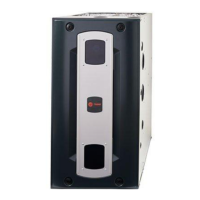
Do you have a question about the Trane DD060R9V3F Series and is the answer not in the manual?
Alerts to risks of carbon monoxide poisoning from improper venting of gas appliances.
Warns about potential fire or explosion risks due to improper handling or servicing.
Advises against using the furnace as a construction heater to prevent premature damage.
Prohibits installation in corrosive or contaminated environments to prevent damage.
States furnaces are not approved for mobile housing, trailers, or RVs, warning of damage or injury.
Instructs against direct installation on carpeting or tile; requires subbase for downflow applications.
Details required clearances from furnace to combustible materials for various installation types.
Specifies clearances for downflow, horizontal closet, and alcove installations to combustibles.
Warns against direct installation on combustible flooring; requires subbase for vertical downflow applications.
Defines confined spaces and outlines air supply requirements for combustion and ventilation.
Lists substances in air supply that necessitate outdoor air for combustion.
Specifies the minimum air entering temperature for the furnace.
Advises remote filter installation for horizontal applications to prevent damage or injury.
Instructs to turn off power before servicing filters to prevent injury from moving parts.
Details the process of installing the filter rack in the bottom of the furnace.
Provides instructions for relocating the filter rack for side return air on upflow furnaces.
Explains how to remove the blower door or hinge for clearance or other issues.
Describes installing alternate filter clips or brackets for upflow furnaces.
Prohibits venting into unlined masonry or concrete chimneys due to safety risks.
Details requirements for venting into lined internal masonry chimneys, including common venting.
Emphasizes thorough inspection of chimney liners for cracks to prevent leaks and deterioration.
Highlights the necessity of proper electrical grounding for safety and to prevent shock or fire.
Warns that the integrated furnace control is polarity sensitive and requires correct hot leg connection.
Instructs to disconnect electrical power before servicing to prevent shock or injury.
Provides wiring diagrams for single-stage and two-stage heating thermostats, including installation notes.
Explains how to connect an optional humidistat and modify factory jumpers.
Reiterates the danger of using open flames for gas leak detection and storing flammables nearby.
Advises using a backup wrench during gas piping installation to protect the gas valve.
Complies with California law, warning about exposure to fuel substances and combustion by-products.
Details the procedure for adjusting manifold pressure on the White-Rodgers 36E gas valve model.
Details the procedure for adjusting manifold pressure on the White-Rodgers 36G gas valve model.
Warns to replace/tighten all plugs and leak check fittings after adjusting gas pressure.
Provides guidance on selecting orifices for altitude adjustments and checking input rates.
Lists essential checks to perform before initiating the startup sequence.
Directs users to unit-specific instructions and outlines the initial checkout process.
Describes the operation sequence for 2-stage heating based on thermostat signals.
Outlines the operation sequence when using a 1-stage thermostat.
Explains blower operation when the thermostat fan switch is set to 'ON'.
Details how to test the limit switch for proper operation and overheating shut-off.
Explains how the Integrated Furnace Control manages blower timing for heating and cooling.
Guides on setting the thermostat's heat anticipator based on measured current flow.
Covers issues like excessive pressure, loss of flame, power failure, gas supply loss, and inducer failure.
Details procedures for system lockout and manual reset after errors.
Warns about fiberglass insulation causing cancer and respiratory irritation, with precautionary measures.
Provides emergency steps to take if gas is detected, emphasizing safety.
Indicates normal system status: no heat call (slow flash) or call for heat (fast flash).
Covers errors like IFC failure, power issues, lockout, pressure errors, limit circuits, flame sense, gas valve, and low flame signal.












